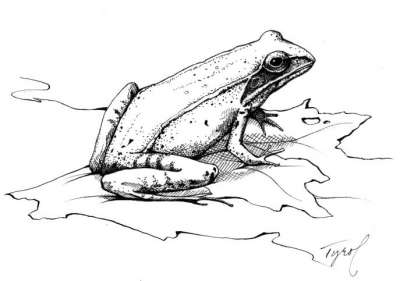
It was a busy summer in the pond at the foot of my hill. Hundreds of wood frogs mated there. I watched their eggs hatch, watched as tadpoles grew up, got legs, lost tails, and headed for the woods for which they are named. There, I assume, they spent the summer and fall fattening up on insects. But where are they now that there is no more food to be found and ice and snow have covered the ground?
Some frog species burrow into the mud at the bottom of the pond, insulating themselves against freezing air temperatures, but wood frogs have evolved a different strategy. They accept a frozen fate by digging down into a couple of inches of leaf litter.
Samuel Hearne, journeying in the Arctic in 1769-1772, described them: “Frogs of
various colours are numerous in those parts as far North as the latitude 61 degrees…. I have frequently seen them dug up with the moss, frozen as hard as ice; in which state the legs are as easily broken off as a pipe-stem… but by wrapping them in warm skins, and exposing them to a slow fire, they soon recover life.” He was likely referring to our wood frog, Rana sylvatica, found both in the Arctic and here in northern New England.
Although the wood frog has been the most extensively studied, other amphibians also possess this ability to tolerate freezing: the gray tree frog, spring peeper, and chorus frog, along with one species of Siberian salamander, the immature spotted turtle, the eastern box turtle, the pond-slider turtle, and the garter snake, as well as numerous invertebrates.
As you can imagine, freezing is tough on most creatures. Ice crystals damage cells, causing them to rupture and collapse. Toxins build up in cells and cause nervous system dysfunction. Increased heart rates and damage due to rapid cooling are also potential hazards that could lead to death.
This does not seem to intimidate the wood frog, which, unlike humans in the Northeast, does very little to prepare for the long cold winter. The single preparation this frog makes is to store glycogen in its liver. In the fall, these animals may harbor 2-10 times more of this substance than pond-hibernating species.
Once temperatures drop below freezing, and water just inside the skin of the frog starts to freeze, the wood frog rapidly transforms this glycogen into glucose, which serves as antifreeze. Blood glucose can increase up to 200-fold in response to freezing. Besides manufacturing antifreeze, freeze-tolerant frogs are able to evacuate water from major organs, thus reducing the formation of ice in these critical areas. (Some plants have a similar ability to protect sensitive tissue.) Up to 65 percent of the frog’s body-water in the intercellular spaces can freeze without causing damage. The glucose, meanwhile, keeps the water remaining inside the cells from freezing.
One strange twist in the process is that as water turns to ice, heat is given off, and it is this heat that saves the frogs from cooling too rapidly. They can freeze, but they mustn’t freeze too fast!
Frozen dissected frogs appear dead. There is no sign of breathing or blood flow. Organs appear bloodless. Heartbeats are absent or intermittent. If there is a mid-winter thaw (or, in the case of Samuel Hearne, warm skins and a blazing fire), glucose levels subside and the frog thaws. The organs with the highest glucose levels (liver, heart, kidney) thaw first, allowing metabolism to start back up. This process can fluctuate back and forth throughout the winter. Because thawing is slower than freezing, and because there is usually a nice thick blanket of insulating snow, the frogs are not likely to thaw many times during the winter.
The temperature to which frogs freeze and the length of time they remain frozen is crucial. One hundred percent will survive frozen to –1.5 degrees C for 14 days, but only 50 percent will survive at this same temperature for 28 days. None will survive temperatures as low as –30 degrees C. A cold winter with no snow, therefore, would be devastating to the local wood frog population.
It is not clear why some frogs have evolved this freezing strategy. Maybe there is some danger that lurks for them under the protection of an ice-covered pond, leading them to choose a different winter home. Or maybe they couldn’t stomach the idea of being trapped under a foot of ice all winter with a bunch of bull frogs. Either way, they have what it took to develop the mechanisms needed to withstand freezing.


Discussion *